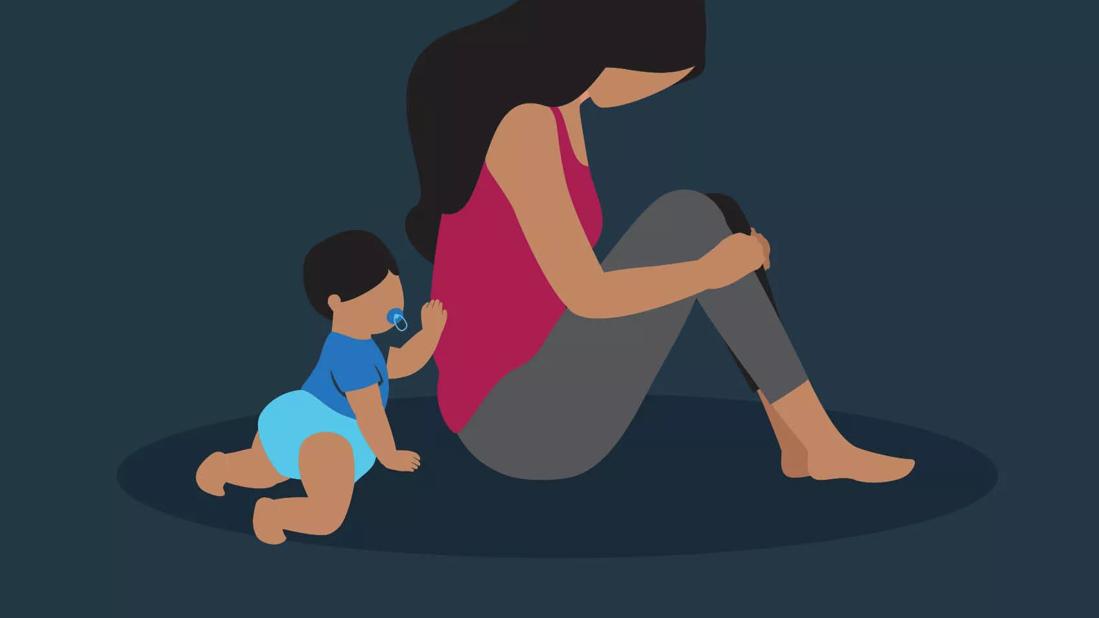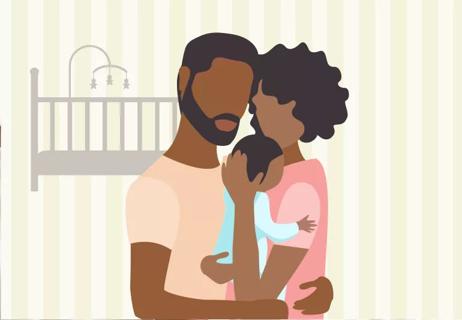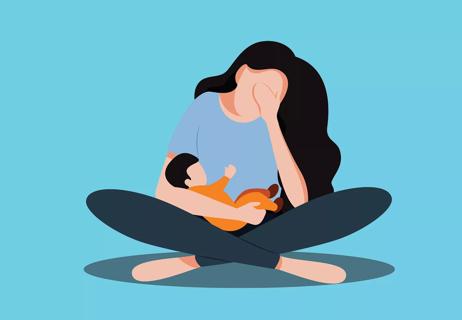Heavy bleeding, pain and persistent sadness could be something more serious

Giving birth to a baby is an experience unlike any other. It doesn’t matter if it’s your first time or you’ve been down this road before, each birth and each postpartum recovery is different.
Advertisement
Cleveland Clinic is a non-profit academic medical center. Advertising on our site helps support our mission. We do not endorse non-Cleveland Clinic products or services. Policy
The postpartum period, or the fourth trimester, can come with a certain amount of discomfort. Soreness, tiredness and some emotional changes are to be expected. Your body has been through a major change, and your hormones are changing rapidly, too.
It’s also normal to wonder if what you’re experiencing is just run-of-the-mill labor recovery or a sign of something to be taken seriously.
We talked to Ob/Gyn Salena Zanotti, MD, about what’s normal — and what postpartum symptoms you shouldn’t ignore.
Before you’re discharged from the hospital, your provider will likely share some advice regarding what’s normal after giving birth and when you should call them. Of course, there are a lot of other things probably going through your head at the time, so it may be hard to remember it all.
“After delivery, it can be hard to know what to ask or what to look out for until it happens,” Dr. Zanotti notes. “Everyone recovers from delivery differently. If you’re experiencing something that’s worrying you, it’s never a bad idea to reach out with questions. If nothing else, it can be helpful to get some peace of mind.”
Dr. Zanotti shares these top symptoms that you shouldn’t ignore after giving birth.
Advertisement
Postpartum bleeding is to be expected. The vaginal discharge that happens after delivery is called lochia, and it can be quite heavy for those first few days.
“Lochia is your body clearing out any leftover blood, tissue and other materials after pregnancy,” Dr. Zanotti explains.
Bleeding can be heavy at first and is usually dark red. After three days or so, it should slow down and become lighter in color. Light bleeding and discharge can last up to six weeks.
You’ll experience postpartum bleeding whether you give birth vaginally or had a cesarean delivery (C-section). Women who have C-sections may have less bleeding than those who deliver vaginally, but it may still last several weeks.
During this time, your provider will recommend you use a maxi pad for the bleeding — not a tampon. Regardless of how you delivered, you shouldn’t insert anything in your vagina until you’ve been cleared by your provider, usually about six weeks after delivery.
Bleeding is usually starting to get lighter by the time you leave the hospital. If you still have to change pads multiple times per hour after you’ve left the hospital or if you persistently pass blood clots larger than a golf ball, contact your provider for guidance. These can be a sign of postpartum hemorrhage.
Also check with your provider if your bleeding increases again after initially slowing down or if you notice signs of infection, like foul-smelling discharge.
During pregnancy, your uterus expands. After delivery, it’ll start to return to its normal size. That can take some time, and cramping is common.
“Cramping during the postpartum phase can be pretty intense — almost like a contraction,” Dr. Zanotti says. “Breastfeeding accelerates the process, too. It can make these twinges more noticeable, especially in the first few weeks.”
Cramps that come and go and don’t last longer than about five minutes are normal. But if you’re experiencing pain that’s severe or steady, it’s time to contact your provider.
Consistent abdominal pain can be a sign of postpartum endometritis, a bacterial infection in the lining of your uterus. It may also be accompanied by a fever, chills or generally feeling unwell.
You may have heard about preeclampsia, a serious condition where you develop high blood pressure during pregnancy. What you may not know is that you can develop preeclampsia after giving birth, too, regardless of whether you ever had high blood pressure or had preeclampsia during your pregnancy.
Advertisement
The telltale sign of preeclampsia is high blood pressure (140/90 mmHg or higher), but most of us aren’t regularly checking our blood pressure at home.
Dr. Zanotti says one of the most common symptoms of postpartum preeclampsia is a severe headache. You may also experience:
Postpartum preeclampsia is rare but can be very serious. It’s most common in the first few days after giving birth, but can happen up to six weeks after delivery. Contact your provider if you’re experiencing headaches or other signs.
You may go home after giving birth with stitches. That can come from tearing naturally, from an episiotomy (a cut a provider makes to aid in delivery) or a C-section incision.
Most of the time, tears and incisions heal without issue, and stitches dissolve on their own. Before you head home, talk to your provider about what you should expect as you heal.
In rare cases, tears, episiotomies and incisions may become infected. Seek medical attention if you have a fever, notice foul-smelling discharge or if your pain gets worse instead of better, as those could be signs of an infection.
It’s common to experience some urinary leakage at the end of pregnancy and during the first few weeks after giving birth. For most women, Dr. Zanotti recommends Kegel exercises to help tighten up your pelvic floor muscles and stop the leaking.
Advertisement
But you may experience bowel leakage after giving birth, particularly if you've experienced a larger tear during delivery.
If you have leaking urine, gas or bowel movements, or if you have any pelvic floor weakness, talk to your provider. You may benefit from pelvic floor physical therapy.
It’s normal to have some discomfort urinating after giving birth. It may sting a bit when you pee, particularly if you’ve had stitches. Your provider may recommend using a squirt bottle with room temperature water to ease the discomfort while you pee and to help clean yourself. That discomfort should begin to subside in the first week or so after giving birth.
If the feeling is more intense, it could be a sign of a urinary tract infection (UTI). UTIs are pretty common after giving birth, particularly if you had a catheter.
Talk with your provider if it burns when you pee, if you feel a sharp pressure or pain when you pee or if you feel the urge to go frequently.
After giving birth, you may be at a higher risk of blood clots, and not only from shedding the lining of your uterus, Dr. Zanotti states.
“During pregnancy, your blood volume increases in order to care for the developing fetus,” she explains. “After giving birth, your blood may clot more easily, which can put you at a higher risk for developing blood clots in your veins, which can travel around your body and be very serious.”
Advertisement
Your legs are one of the most common places for blood clots to develop during postpartum recovery. In part, that’s because late in pregnancy, you may have less blood circulation in your legs.
Signs of a blood clot in your leg, also called deep vein thrombosis, include leg pain, as well as redness, swelling or warmth in your legs. Contact your provider right away if you notice these symptoms.
Blood clots can travel from your leg to your lung and stop blood flow into your lung. This is called a pulmonary embolism, and it can be very serious.
Symptoms of pulmonary embolism include shortness of breath, chest pain and coughing. You also may cough up bloody mucus.
If you’re concerned you have symptoms of a pulmonary embolism, quick treatment is important. Seek prompt medical attention.
After giving birth, your breasts will experience some changes as your milk supply comes in and regulates. Engorged breasts and discomfort are normal, particularly in the first few weeks after giving birth.
If you are breastfeeding, you’ll become more used to what’s normal and what’s not when it comes to changes in your breasts. Some lumps and feelings of “fullness” can come and go in between feedings.
But if you’re breastfeeding and experience symptoms like breasts that are painful, burning, warm to the touch or have red streaks, it may be a sign of mastitis. Mastitis is an infection that can happen if your milk ducts become clogged.
Talk with your healthcare provider about these symptoms, as most cases of mastitis require antibiotics. If left untreated, mastitis can lead to a breast abscess.
Around 70% to 80% of women report feelings of sadness or bouts of tearing up after delivery. It’s called the baby blues. It’s a normal reaction to the fatigue of the postpartum period and the hormonal rollercoaster that delivery causes.
Asking for help from a partner, friends and family can help you get the rest you need and help manage the emotional toll. Baby blues should start to lighten up by about two weeks after delivery. But it doesn’t always.
Lasting sadness, continued feelings of being overwhelmed and thoughts of hurting yourself or your baby are signs of postpartum depression. If your symptoms persist or worsen instead of improve, it’s time to contact a provider.
“A lot of people think that after having a baby, you’re supposed to be on top of the world, but in truth, it’s not like that a lot of times,” Dr. Zanotti recognizes.
“The first few weeks after delivery can be a very stressful time. If you’re consistently feeling too overwhelmed and unable to take care of yourself or your baby, those are signs of postpartum depression, and you should seek help — both for your health and for the wellbeing of your baby.”
Learn more about our editorial process.
Advertisement

Yes, new fathers can experience mood changes after bringing baby home

But if you’re worried, don’t hesitate to call your doctor or midwife

A timeline of what to know after delivering your baby

Having sex after giving birth isn’t only about being medically ready

It’s normal to experience some changes

Belly wraps provide physical support after you give birth

Sad feelings and teariness that persist are a sign

Patience is the best solution

The best parenting style balances enforcing rules and showing plenty of love

Tips include cutting back on sugar, focusing on exercise and managing stress

It can be harder to let go when you’ve invested time, energy and emotions — but it might be the healthier choice long term